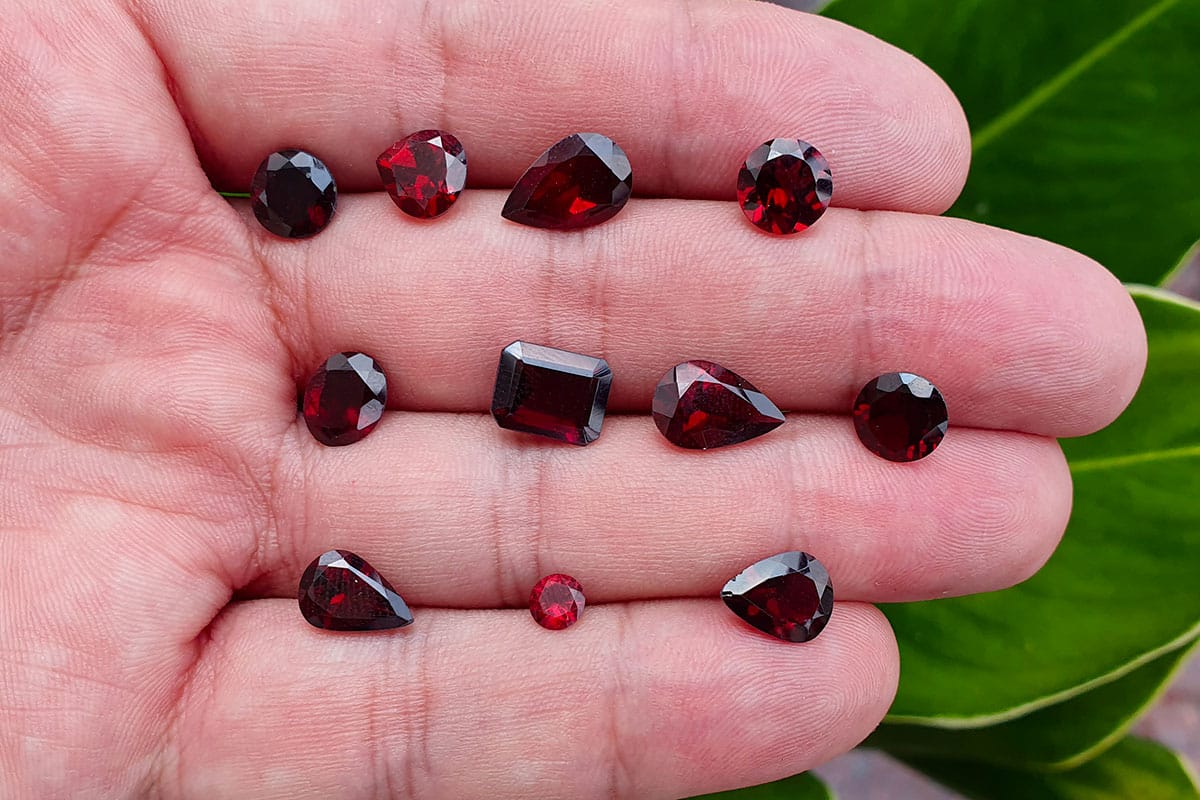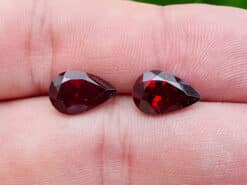Pyrope garnet

Pyrope red garnet is the birthstone of January.
Buy natural pyrope garnet in our shop
The mineral pyrope is a member of the garnet group. It is the only member of the family to always display red coloration in natural samples, and it is from this characteristic that it gets its name from the Greek for fire and eye.
Despite being less common than most other colors, it is a widely used gemstone with numerous alternative names, some of which are misnomers.
Composition
Pure pyrope is Mg3Al2(SiO4)3, although typically other elements are present in at least minor proportions. These other elements include Ca, Cr, Fe and Mn.
The stone forms a solid solution series with almandine and spessartine, which are collectively known as the pyralspite garnets: pyrope, almandine and spessartine.
Iron and manganese substitute for the magnesium in the stone structure. The resultant, mixed composition garnets are defined according to their pyrope-almandine ratio. The semi-precious stone rhodolite is a garnet of 70% composition.
Origin
The origin is in ultramafic rocks, typically peridotite from the Earth’s mantle: these mantle-derived peridotites can be attributed both to igneous and metamorphic processes. It also occurs in ultrahigh-pressure metamorphic rocks, as in the Dora-Maira massif in the western Alps.
In that massif, nearly pure stone occurs in crystals to almost 12 cm in diameter; some of that gem has inclusions of coesite, and some has inclusions of enstatite and sapphirine.
The stone is common in peridotite xenoliths from kimberlite pipes, some of which are diamond-bearing. It found in association with diamond commonly has a Cr2O3 content of 3 to 8 %, which imparts a distinctive violet to deep purple coloration, often with a greenish tinge, and because of this is often used as a kimberlite indicator mineral in areas where erosive activity makes pin pointing the origin of the pipe difficult. These varieties are known as chrome-pyrope.
Pyrope garnet identification
In hand specimen, It is very tricky to distinguish from almandine, however, it is likely to display fewer flaws and inclusions. Other distinguishing criteria are listed in the adjacent table. Care should be taken when using these properties as many of those listed have been determined from synthetically grown, pure-composition stone.
Others, such as high specific gravity, may be of little use when studying a small crystal embedded in a matrix of other silicate minerals. In these cases, mineral association with other mafic and ultramafic minerals may be the best indication that the garnet you are studying is pyrope.
In petrographic thin section, the most distinguishing features of the stone are those shared with the other common stones: high relief and isotropy. It tend to be less strongly colored than other silicate minerals in thin section, although It may show a pale pinkish-purple hue in plane-polarized light.
The lack of cleavage, commonly euhedral crystal morphology, and mineral associations should also be used in identification under the microscope.
Garnet birthstone
Garnet is the birthstone of January.
Pyrope garnet meaning and healing properties benefits
The following section is pseudo scientific and based on cultural beliefs.
Use its healing powers to boost circulation and blood disorders, as well as the digestive tract and immune system. The crystal emotionally relieves anxiety, and promotes composure, courage and endurance. the stone stimulates warmth and gentleness, unifying the creative forces of the self.
Sample from Pailin, Cambodia
FAQ
Are red pyrope garnets expensive?
Fine quality stones in larger sizes sell for $50 to $400 US per carat, with the very rare pink Malaia garnets going for $1,000 to $3,000 US per carat. Rhodolite garnet is a mixture of almandine and pyrope garnet that is valued for its purplish-red or raspberry color.
How big is a 1 carat garnet?
Size: Around 6.5 mm round cut
Can you wear garnet everyday?
The gemstone can be worn every day in the form of earrings, rings, and necklaces, with the exception of demantoid, which is more suited to necklaces and pins. Try wearing deep red stones with different colors in your wardrobe.
What is red garnet good for?
Because it’s such an energizing stone, It is often used for manifestation purposes and worn as a talisman for good luck. In addition to bringing vitality, high energy, and protection, garnet also helps build self-confidence and clarify one’s life purpose.
Is garnet a lucky stone?
It is considered a lucky stone, for love, success, and for business relationships.
Do garnets chip easily?
Furthermore, gemstones are not brittle, does not chip easily and as such are considered better candidates for jewelry that is in everyday use than Emeralds. Another very important property of some garnets is their ability to appear in different hues in natural and artificial light.
Is garnet harder than quartz?
Diamond is graded the hardest (10), followed by ruby and sapphire (9), garnet, topaz, and spinel (8), emerald, tourmaline and quartz (7).
Natural pyrope garnet for sale in our gem shop
We make custom made pyrope garnet jewelry as engagement rings, necklaces, stud earrings, bracelets, pendants… Please contact us for a quote.
















